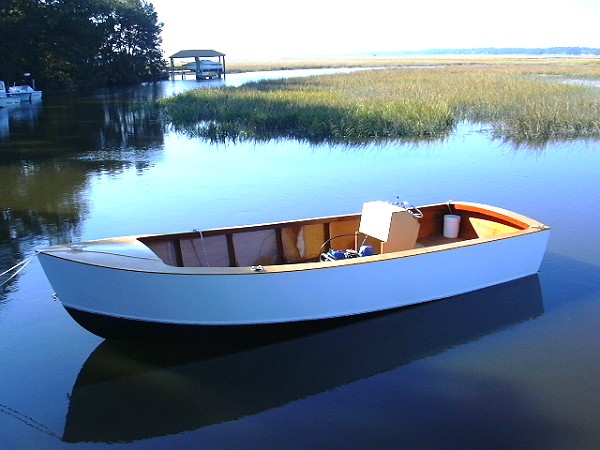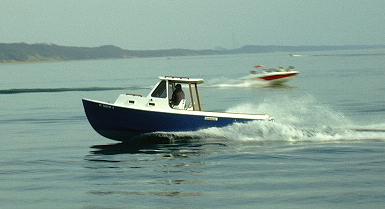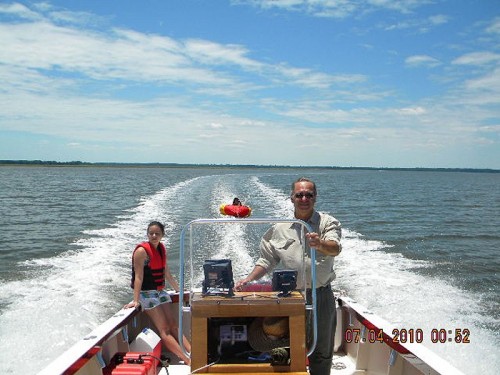Wooden Boat Interview: Double Eagle
Posted by Gayle Brantuk on Jan 20th 2011
Ken Schott first launched his almost completed Double Eagle a 25 foot wooden fishing boat at the very first Gathering of Boatbuilders at Lake Guntersville in Alabama. What an exciting event that was! Ken beamed from ear to ear with pride in the boat he built himself. What an awesome accomplishment and how great to launch with like-minded friends gathered ’round…
Ken's Double Eagle
Of course, on the road trip to the Gathering, Ken lost the floorboards for his boat somewhere on the highway! Oh well, what’s a little more wood and some good time in the shop?
Ken built his Double Eagle with fishing in mind so he left off the cabin as shown on the plans to keep the boat open and very spacious. Plus, he lengthened it from 23′ to 25 foot.
Gordon Groenvelt's Double Eagle with cabin
The Double Eagle can be built in plywood or aluminum and Ken chose the wood version. Either one can be powered with an inboard up to 875 pounds, an I/O from 400 to 600 pounds , or single or twin outboards from 200 to 325 pounds.
He wanted to add a little brightwork to his painted hull, so he decided to do this with the transom. Ken used mahogany for the transom applied in strips using a vacuum bagging technique that he details online.
Ken didn’t keep track of his cost because he bought what he needed and had cash for at the time. This is one of the benefits of building your own boat–pay as you go. Ken was also good at locating deals and found a four-cylinder sterndrive from an old boat for a really good price. He describes his motor in one of our WebLetters.
It took him about 5 years to build his boat as he worked in his spare time while working full time. Ken provided many detailed building photos and articles and was featured in many of our WebLetters. The Double Eagle patterns are given for half of the frames because they are the same on both sides. Ken wrote a detailed article on the process he used to work with these half patterns.
Another way to trace the other half of the pattern is to place two sheets of transfer paper under the pattern, one facing toward the pattern, one facing toward the wood and then trace. Then you can flip the pattern over, making sure to align the centerline and transfer the other half to the wood.
Sometimes it’s difficult to find full length wood for many of the longitudinals on a boat, so Ken created a jig for making scarf joints for his battens and gave a detailed photo description of it. He also created a very clever steam box that he says can steam battens, sheers, chines, clams, crabs, & shrimp. Works good as a turkey fryer too!
You know, I started this article as an addition to a great interview that we did of Ken back in 2009. What I had forgotten was the huge amount of information that he provided while he was building. This level of contribution is something that we see frequently on our Forum and from those of you who like Ken, submit articles to us for the WebLetter.
I can’t stress how valuable this is to new builders and people just learning the “ropes” of building a boat. Besides all of the great information Ken provided on his build, he also acted as a “Roving Reporter” for Glen-L for a period of time or as Barry called him, our “Intrepid Correspondent”. He reported on the Motor Torpedo PT 728 , the “Falls of Clyde” tall mast cutter and Battleship Missouri, both in Hawaii.
Ken–I thank you publicly for all you’ve contributed to Glen-L in the form of articles, patient assistance on the Forum, cooking a great low country boil for every Gathering, helping to organize the Gatherings, your emails and phone calls over the years with ideas and suggestions and for your friendship. It’s guys like you that give way more than expected and continue to amaze us. And, your boat is awesome!
A day of fun with the family!


